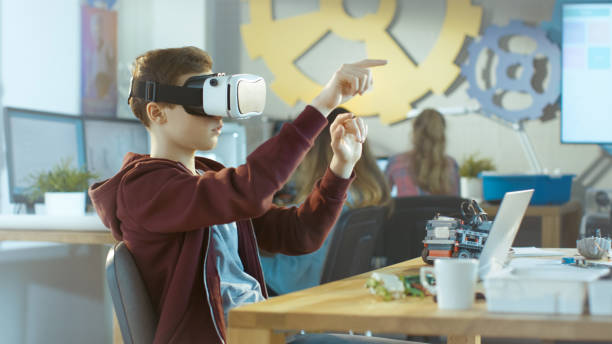The end of the twentieth century witnessed three revolutions in information technology sciences. The first revolution was represented by the emergence of the personal computer. Its appearance was a turning point in human history. The second revolution was represented by the emergence of the Internet, which had and still has a great impact on all aspects of science and life.
It was represented by the enormous and massive information revolution, which brought about a new qualitative shift in human life. It is no wonder that we find phones without wires, books published without papers, electronic real estate, home shopping, digital money, and smart cards.
The Concept of Virtual Reality
Virtual reality is one of the most important and latest computer applications. It is concerned with designing an artificial, three-dimensional environment. It works to transfer human consciousness to a virtual environment. Furthermore, it is formed electronically by freeing the mind to delve into implementing imagination away from the location of the body. So, events take place in the assumed reality and not in reality.
Characteristics of the virtual reality environment
1- Interactive
The degree of interactivity depends on the extent to which the system allows for interactions and events that the user performs when interacting with the components of this system and the extent of the use of virtual reality tools and technologies that allow complete immersion and direct interaction with virtual environments.

It also allows the user of virtual reality applications to interact with the contents of these environments through providing freedom for individuals to roam, as well as direct interaction and modification of virtual objects through the formation, creation, and completion of additional or incomplete parts. Interactivity is not limited to the operations performed by the user but extends beyond that to the system’s response to what the user does as well.
2- Participation and cooperation
Participation is one of the important and distinctive features of virtual reality shows. Especially those shows that are published on the international information network, and they are designed according to a group of factors.
This includes supporting multiple users, where a group of individuals can use the same virtual reality application at the same time. A group of users of the virtual reality system at the same time so that each of them can interact alone. This interacts with the presence of others by performing specific tasks to ultimately achieve the educational goal of the virtual environment.
3- Immersion
It is the user’s feeling of virtual reality environments and applications that he is completely surrounded by the components of this environment. Therefore, within this environment, he interacts as one of its components.
The user in traditional multimedia applications looks at them from the outside and cannot enter them. While in virtual reality the individual fully experiences the virtual educational experience. To a degree that makes him believe that he is dealing with a real reality, not an imaginary one.
4- Remote Attendance
The person feels his presence and presence within the virtual reality environment. It’s as if he has moved mentally and physically to a place other than the place he is in.
5- Simulation
It is considered one of the most important characteristics of virtual environments. The user here simulates natural reality and real experience in an artificial-imaginary environment that does not exist in real reality. Rather, they are tools and means that enable the user to simulate a specific environment in which he wants to learn, as if he were inside this real environment.
6- Sailing
Navigation is one of the most important characteristics of virtual reality environments. It means the process of moving and retracing that the user uses in selecting the content of the virtual environment and interacting with it. It is the process that helps the user navigate between different parts of the content in the virtual environment, enabling him to review and access it with the aim of learning about the content. And then acquire it.
7- Ability to modify
A distinctive feature of virtual reality environments as it allow the user to directly modify objects in real time. Either by changing their position, direction, or dimensions, and they can be modified. It increases the user’s sense of immersion and presence in those environments.
8- Self-control
The virtual reality environment is a dynamic environment that operates according to an integrated, sequential system, and all the atmosphere of that environment is controlled by the elements of self-control and dynamic movement.
Also Read: 7 Tips to Discover Your Inner Superhero
The importance of virtual reality in education and training
1- It is an effective way to simulate the traditional learning environment, regardless of its circumstances and difficulty. Through it, different environments can be created that simulate reality that the learner cannot access or coexist with, for example. The learner cannot live in the space environment in school, and here comes the role of the virtual learning environment. 3D creates an environment that resembles the traditional environment. It enables the individual to interact with it as if he were in the traditional environment.
2- It works to simplify the complex real reality, as real reality is complex and full of events and details that distract attention. The virtual reality environment adopts only what is required to focus on.
3- It contributes to increasing interactivity, control, and individualization, as virtual reality requires high levels of interactivity and educational control. Because the learner is the one who decides what to do. Increasing interactivity and control leads to an increased level of individualization, and this in turn leads to increased learning.
4- Contributing to diversifying the use of learning strategies and methods within the virtual learning environment. Strategies for cooperative and participatory learning, discussions and role-playing, project-based learning, and problem-solving can be presented.
5- It contributes to training in practicing skills that are difficult to interact with in real-life environments. Training to perform a heart operation. Through virtual reality, a virtual heart can be created for them to practice before performing the actual heart operation.
6- Provide academic content so that the learner can enter and leave the environment and navigate around. The information at any time and in any place without resorting to setting timetables for study dates as in the traditional environment.
FAQs
What does virtual reality mean in the context of education?
Creating a synthetic, three-dimensional environment that electrically submerges participants in a virtual world is known as virtual reality in education. People may interact with the information in this environment just as they would in a real, physical context.
How Can Virtual Reality Improve Education?
High levels of interaction, engagement, immersion, remote attendance, modeling of real-world experiences, and navigation. The capacity to alter things in real-time and self-control are just a few of the features that virtual reality settings offer that improve learning.

